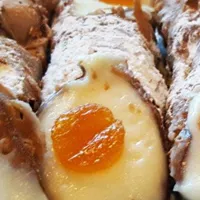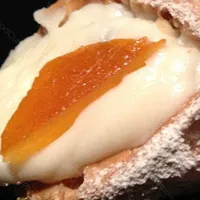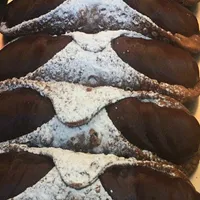Published:
Author: Antonio Maria Guerra
Sicilian Cannoli
HISTORY, INFO, PLACES, INTERESTING FACTS

Cannoli are probably the most typical pastries of the Sicilian tradition. Establishing with precision their origins is not easy: we know for sure that it was the year 70 BC when, in one of his writings, the famous Roman orator Marcus Tullius Cicero described a very similar dessert. Let’s deepen the knowledge of the history of this delicious specialty, let’s find out its ingredient and how it’s made, let’s visit its places, looking for its many variants.

The history of Sicilian Cannoli.
It’s very difficult to determine with precision the real origins of the delicious dessert known as ‘Cannolo’: that’s most probably because Sicily, the Italian island usually considered its birthplace, over the centuries was subjected to the domination and to the cultural influence of many civilizations very different from each other.
If on one hand this clearly represents a source of enrichment, on the other it causes great confusion.
Here follow some of the most interesting theories:
Cicero’s Cannoli: According to historians, something very similar to a Cannolo already existed in the Roman period. In 70 BC, in one of his literary works, the great orator Marcus Tullius Cicero mentioned a: “tubus farinarius, dulcissimo, edulio ex lacte factus” (“A tube prepared with flour and stuffed with a very sweet filling made of milk”).
According to historians, something very similar to a Cannolo already existed in the Roman period. In 70 BC, in one of his literary works, the great orator Marcus Tullius Cicero mentioned a: “tubus farinarius, dulcissimo, edulio ex lacte factus” (“A tube prepared with flour and stuffed with a very sweet filling made of milk”).
These words prove that a ‘primordial’ form of this pastry could date back to the Classical Age.
Notes:
Cannoli and concubines: Many think that the first Cannoli were invented in a harem located in Qalc’at al-Niss, the ‘City of Women’, today’s Caltanissetta. According to this theory, they were prepared by the concubines of a Saracen emir, probably inspired by a recipe belonging to the Arab culinary tradition (*1).
Many think that the first Cannoli were invented in a harem located in Qalc’at al-Niss, the ‘City of Women’, today’s Caltanissetta. According to this theory, they were prepared by the concubines of a Saracen emir, probably inspired by a recipe belonging to the Arab culinary tradition (*1).
Cannoli and nuns:
According to another theory, Cannoli were invented by a group of nuns. It’s probably not a coincidence that their convent was right in Caltanissetta. They used to make this delicacy during the Carnival.
Nuns and concubines:
Some historians believe that, when the Normans expelled the Saracens from Sicily, a few concubines escaped from the harem in Qalc’at al-Niss and took refuge in the local convent, where they converted to Christianity and formed a deep bond with the nuns. If this fact could be proved, Cannoli would probably be the result of a mix between the Arab and the Roman / Classic culinary traditions.
Notes:
*1: The ancestor of the Cannolo could be the ‘Qanawat’, a pastry from the homonymous village of Syria.
Sicily: the birthplace of Cannoli.
The Italian region of Sicily is an island located at center of the Mediterranean. A very fascinating place that, over the millennia, hosted a great number of civilizations.

Where to eat the original Cannoli?
Here follows a list including some of the most traditional pastry shopy of the city of Palermo: places where it’s possible to savor the original Cannoli.
Read more
- I Segreti del Chiostro
Piazza Bellini, 33 – Palermo (Italy)
Official Website; - Pasticceria Cappello
Via Colonna Rotta, 68 – Palermo (Italy)
Official Website; - Pasticceria Oscar
Via Mariano Migliaccio, 39 – Palermo (Italy)
Official Website;

The ingredients of Sicilian Cannoli.
Even if in Sicily Cannoli have a common, basic recipe, it’s important to notice that there are actually some differences, depending on the province where they are prepared.
Here follows a list of the ingredients most frequently used and some possible alternatives:

The ingredients for the ‘scorza’:
The ‘scorza’ container, is prepared using a dough made with flour, lard, sugar and wine (generally Marsala).
Read more
Once the dough has risen, it’s stretched and cut in small discs: these are rolled on metal cylinders and finally fried in lard or olive oil until an even browning is achieved.
Main ingredients:
- Flour;
- Lard;
- Sugar;
- Salt;
- Marsala wine;
Alternative ingredients:
- Honey (instead of sugar and lard);
- Butter (instead of lard);
- Cacao (optional);
- Eggs (optional);
- Vinegar (optional);

The ingredients for the filling:
The main ingredient for the filling of a Cannolo is ricotta cheese, made exclusively with sheep’s milk.
Read more
The only exception are the Cannoli prepared in the city of Ragusa, where vaccine milk is used instead. Sometimes the filling is enriched with chocolate drops or different types of candied fruit.
Main Ingredients:
- Ricotta cheese;
- Sugar;
- Vanilla;
Alternative ingredients:
- Cinnamon (optional);
- Dark chocolate drops (optional);
- Candied fruit (optional);

The origin of the name ‘Cannolo’.
Where does the name ‘cannolo’ (*1) come from? There are two hypotheses:
Read more
- The first one, the most credible, suggests that it comes from ‘canna’, the Italian for river cane: this was once used to roll the dough to make the ‘scorza’ (*2), also known as ‘buccia’ (peel). Nowadays, for hygiene reasons, canes have been replaced by special steel cylinders. They are probably more healthy and practical, but also much less ‘romantic’.
- The second hypothesis derives from a legend. It is said that once upon a time, during the Carnival, some cream mysteriously came out from the tap of a fountain, whose Italian translation is also ‘canna’. In truth, it was just a joke, a little trick devised to make fun of a passer-by. Many think this is how the famous dessert got its name (*3).
Notes:
*1: In the Italian language, ‘Cannoli’ is the plural of ‘Cannolo’.
*2: The ‘scorza’ is also known as ‘scoccia’ or ‘scorcia’.
*3: Some people claim that this joke led not only to the invention of the name but also of the pastry itself.

Sicilian Cannoli: a mix of sacred and profane.
Cannolo is a pastry rich in symbolic meaning: a fascinating mix of sacred and profane.
Read more
Let’s consider, for example, its origins: some claim it was invented by the concubines of an emir, some others by the nuns of a convent. The devil and the Holy water.
Also, many think there is a resemblance between its shape and that of a penis. From this point of view, the filling would represent the female genitalia.

The filling for Sicilian Cannoli.
One of the most important characteristics of a very good Cannolo is the balance between the crispness of its container, the ‘scorza’, and the softness of its filling, the ‘farcitura’. The right combination of these two different textures is a fundamental feature of this pastry, something that must be achieved and preserved at all costs, especially by preventing the moisture of ricotta cheese from softening the waffle.
Read more
That’s why the best Cannoli should be filled just a few minutes before they are served. In case this dessert is not going to be eaten immediately, some pastry shops prefer to sell the ‘scorza’ and the ‘farcitura’ separately: this way their customers can combine the two parts when it’s needed. Some other shops use a different method, by covering the inner surface of the scorza with a thin layer of chocolate, thus ‘shielding’ it from the moisture.

Sicilian Cannoli and pistachios.
Chopped pistachios are probably the best topping for Cannoli. Those cultivated in Bronte, a small village near the city of Catania, are particularly delicious. They come from plants growing on the rugged lava soils of Mount Etna, one of the largest volcanoes in Europe.
In 2009 the EU recognized their quality and granted them the Protected Designation of Origin (PDO).
In Sicilian dialect, the name for pistachio is ‘frastuca’, a word of Arab origins.

Little known facts about Sicilian Cannoli.
Here follows a brief list of a few interesting facts about Sicilian Cannoli:
- In Sicily, Cannoli should be given as a present to friends and relatives in a number of twelve (the months of the year) or its multiples, as a wish for good luck and prosperity.
- Cannolo is one of the Italian Traditional Foods (PAT).
- Cannoli were once made just during the Carnival period, nowadays they are prepared throughout the year.

The variants of Sicilian Cannoli.
There are many types of Cannoli in Sicily: their differences depend on the province where they are prepared. It’s just impossible to say which one is the best: it’s just a matter of taste!
These are the most famous and appreciated:
 Cannoli from Piana degli Albanesi: Many ‘experts’ claim that the Cannoli from Piana degli Albanesi (*1), a small village not distant from Palermo, are the best in Sicily. A reputation due to the great skill of local bakers and to the quality of ricotta cheese.
Cannoli from Piana degli Albanesi: Many ‘experts’ claim that the Cannoli from Piana degli Albanesi (*1), a small village not distant from Palermo, are the best in Sicily. A reputation due to the great skill of local bakers and to the quality of ricotta cheese.
 Cannoli from Dattilo: Cannoli from Dattilo, a village near the city of Trapani, are renown in Sicily for their great size.
Cannoli from Dattilo: Cannoli from Dattilo, a village near the city of Trapani, are renown in Sicily for their great size.
The ricotta cheese used for their filling is famous for its taste and flavor.
 Cannoli from Palermo: Many say that the bakers of this city have ‘standardized’ the cannoli recipe and made them famous worldwide. The sides of the Cannoli from Palermo are usually garnished with candied cherries (‘cirase’).
Cannoli from Palermo: Many say that the bakers of this city have ‘standardized’ the cannoli recipe and made them famous worldwide. The sides of the Cannoli from Palermo are usually garnished with candied cherries (‘cirase’).
 Cannoli from Catania: The delicious Cannoli prepared in Catania are usually garnished with chopped pistachios from Bronte, a small village not distant from the city. These pistachios are very famous for their great quality.
Cannoli from Catania: The delicious Cannoli prepared in Catania are usually garnished with chopped pistachios from Bronte, a small village not distant from the city. These pistachios are very famous for their great quality.
 Cannoli from Ragusa: The Cannoli prepared in Ragusa are different from the others for their very delicate taste. That’s because the ricotta used for their filling is made with vaccine instead of sheep milk.
Cannoli from Ragusa: The Cannoli prepared in Ragusa are different from the others for their very delicate taste. That’s because the ricotta used for their filling is made with vaccine instead of sheep milk.
 Cannoli from Messina: The typical Cannolo from Messina has a brown filling made by mixing ricotta cheese and cocoa powder.
Cannoli from Messina: The typical Cannolo from Messina has a brown filling made by mixing ricotta cheese and cocoa powder.
It’s usually garnished with chopped hazelnuts.

The ‘deconstructed’ Cannoli.
During the last few years a very special type of Cannolo has become fashionable in Sicily: it’s the ‘decontructed Cannolo’ (Cannolo ‘scomposto’).
Read more
In order to make it, the cylindrical waffle (‘scorza’), is cut in many pieces: these are accompanied by the same ricotta normally used for the filling, or by other creams. The dessert may be completed with different types of toppings, like, for example, chocolate sauce.

The right beverage for Sicilian Cannoli.
What to drink with some delicious Cannoli? A good choice is a sweet wine, with a good acidity and persistence. For example, sweet Marsala or Moscato from Pantelleria.
- Its sweetnes balances that of the Cannolo.
- Its taste and smell persistence accompanies that of the Cannolo.
Copyright information.
The images displayed in this page belong to WebFoodCulture, with the exception of:
Public Domain Images:
- Cicerone denounces Catilina, Cesare Maccari 1889 (Wikipedia Link) {PD-Art}
- Pool in the Harem, Jean-Léon Gérôme, 1876 (Wikipedia Link) {PD-Art}
